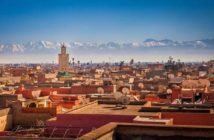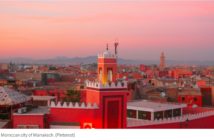Billboard by Nicolas Stecher
The ancient citadel town of Essaouira — known best as Astapor from Game Of Thrones — played host to the 3 rd MOGA Festival, distinguishing itself with a varied lineup of International DJs, Moroccan artists and a hypnotic expression of its local Gnawa music.
As the warm sun falls on the Moroccan coastline and the sky turns Martian orange, the music emanating from the third-annual Moga Festival elevates to an otherworldly vibe.
At the tropical Secret Garden stage, bedecked by hanging vines and colorful flowers, Parallells (French brothers Julien and Thomas de Bie) jam with local legend Malaam Omar Hayat — one of Morocco’s most famous masters of Gnawa (or Gnaoua) music. Born in this timeless city of Essaouira, Gnawa fuses ancient instruments with vocals that feel interplanetary — a mélange of Arabic, the Berber Darija language and a nearly lost dialect that very few Essaourians even speak.
Wielding his three-string ganebri like an acid-soaked Hendrix, the perpetually smiling Malaam plucks at the square bass-like instrument with unbridled joy. The collaboration stirs something deep from within the crowd as the music swings from Parallells’ electronic beats to moments where Malaam and his co-singers take over. The soundtrack is an organic fusion of these two worlds: the gnawa musicians dancing wildly, dipping and ducking, attacking the iron castanet krakebs, while Thomas plays Ray Manzarek melodies on his Nord Stage 2 — a sort of Berber “Riders on the Storm.”
Working the laptop nearby, Julien occasionally adds the lonely wail of a saxophone, layering a melancholy Vangelis Blade Runner vibe to the proceedings. READ MOREMoroccan Label Head Driss Bennis on How the Country’s Emerging Electronic Scene Is ‘Subconsciously Influenced by Our Roots’
The moments when Malaam takes over are undoubtedly the most narcotic. Wearing a traditional white frock and ornate headpiece, Gnawa performance includes guttural singing, which at times sounds more like funereal wailing, hands extended into the sky. The collaboration feels unforced; authentic both to the electronic beats and to the Moroccan Gnawa roots. This really says something, as these cross-cultural pollinations can often feel like trying to smash square pegs.
“You have your typical techno dance moves,” festival co-founder Matthieu Corosine later says, laughing and mimicking the quintessential shoulder waggle typical to festival dancefloors worldwide. “But when Parallells and Malaam Omar Hayat started you could see that [local] people naturally started showing their Moroccan moves. You know what I mean? And that was magical — it felt like they were listening to international music, but they were feeling themselves in it, their own roots. It gave me chills.”
This moment perhaps best embodies the overall philosophy and execution of Moga. Its founders, Corosine and partner Benoit Geli, stated the goal of fusing electronic music with African culture. That’s why they partnered with Casablanca producer and Creative Director Mouley-Abdeslam Alaoui. In 2014, Alaoui threw the first Boiler Room in all of Africa when he organized a gnawa-infused set with Floating Points and James Holden in Marrakech.
“We want to do something that will shine a light on the Gnawa culture,” explains Corosine, “as well as electronic music, influences from all over the world, so they feel impregnated with Essaouira culture.”

This cultural synthesis can sometimes manifest in back-to-back sets teaming Moroccan DJs with Western ones — such as when Amine K, arguably Morocco’s apex producer, spins b2b with New York DJ/producer Sabo; or when Alaoui, or Daox as he’s known here, plays alongside Palestine’s Bas Ibellini. Still, the Parallells x Hayat sunset session which fused and informed music from two continents is the emblematic moment you will not find in many festivals on the planet.
There are other highlights more attuned to a typical underground festival: Diversions Music co-founders OXIA and Nicolas Masseyeff spinning back-to-back, peaking with Prospa’s tasty breaks mover “Prayer”; international stars like Blond:ish, Behrouz and Kenny Dope; Praslea and Raresh bringing their beloved Romanian flavor as Praslesh. There are live sets by Mexico’s Sainte Vie, Berlin and Lima collective Feathered Sun, and Satori who laid down a simmering multi-instrumental session at the head of an expansive, emerald pool.
These international sounds are well enveloped with plenty of homegrown acts, both from home and of the Moroccan diaspora spread across the planet. Casablanca rapper Issam, who recently made waves signing the largest hip-hop record deal ever for an Arab artist, represented the former; his set was Arab Trap madness, and a welcome sonic reprieve from the steady diet of house and techno.

One of the biggest discoveries was Glitter, aka Manar Fegrouch. Having moved from Rabat to Paris a decade ago to study, Fegrouch seasons African flavors on her edits by layering in a harmony of Sub-Saharan and Saharan sounds, vocals and instruments — such as she did on Anturage & Alexey Union’s “Visions.”
“It’s f–king changing,” she tells me of the current Moroccan scene. When she was younger, nothing was percolating, so they had to organize their own small raves. “About five years ago, it started to be cool. We had like four to five electronic festivals. Now there’s some energy, and Moroccan people have started getting curious about electronic music. And that’s cool, that’s what we need — some good energy.”
More than 80 percent of the 6,000 attendees were from Morocco. It’s clear that energy is catalyzing across the North African nation. All in all, Moga takes place over four stages (three outdoor and one traditional nightclub) spread across a sprawling Sofitel resort compound, showcasing 65 artists over three days. Luxurious and well appointed, the Sofitel offers a clean and lush backdrop but fails to offer many visual reminders that you are in fact in Morocco. From the manicured palms and trim grass you could be partying in Marbella, Dubai, or Newport Beach.
There are a couple ancillary events in the town of Essaouira, but it’s a shame the ancient village is not more deeply woven into the fabric of Moga. Having recently gained fame as the filming location for Game Of Thrones’ Astapor, there was a lot of excitement over dancing where Daenerys Stormborn earned her infamous “Breaker of Chains” moniker (where she freed the Unsullied, roasting the slavers like kebab). Corosine explains the initial plan was to party in that courtyard, but when the port became UNESCO protected in 2015, partying in the Skala de la Kasbah was shelved.

As progressive as Morocco is, it’s still a Muslim nation. Very strict alcohol consumption laws make acquiring the necessary permits to drink openly complicated — especially in older parts of town. Given the stunning beauty and profound ancientness of the Medina, this is particularly disappointing.
That’s not to say Moga lacks flavor. It’s one of most exotic festival locations we’ve ever enjoyed. With the indelible richness of Moroccan culture, there are constant reminders everywhere that you are indeed a stranger in a strange land — even in the opulent confines of a 5-star hotel. A large percentage of attendees wear kaftans, flowing robes and pointed Arabic hoodies, and the language and striking beauty of the Moroccan people informs the senses. In the daytime, one can wander the narrow, cobblestone maze of the Medina and eat fresh octopus, shark and dorado just pulled from a fisherman’s net.
Still, both Corosine and Alaoui promise that as Moga expands and their roots (and financing) strengthen in the community, the ancient city once known as Mogador will grow further enmeshed into the fabric of Moga. The 2017 edition, for instance, offered Moroccan cooking lessons, sunset rooftop parties, artisanal workshops, documentary screenings, masterclasses on Gnawa music theory and more. They hope to grow these offerings in future editions, and that can only be a good thing.
The more Essaouira, the better for everyone.







